
Reopened for business at the Nisqually entrance, Mount Rainier National Park / Rebecca Latson
I am trying to be a very careful gal during the coronavirus pandemic. I wear a mask when I go walking and to the grocery store, I wash my hands often, I practice social distancing, and I’ve stayed home (when not getting groceries and prescriptions). Any photography I’ve practiced has been of the spring flowers growing in our yard.
When Mount Rainier National Park quietly reopened it's Nisqually entrance road to Paradise on June 5th, I was curious as to park turnout and wanted to report my findings back to the Traveler. Ok, I was also dying to get out there with my cameras. The Nisqually entrance is only a 2-1/2 hour’s drive from my home in Yakima, so I packed up cameras, tripod, food, water, mask, disinfectant wipes, toilet paper, paper towels, trash bags, tissue toilet seat covers, and lens wipes, then headed out early the morning of June 8th.
The weather was crappy: rain in the lower elevations and fog and snow in the higher elevations. “The Mountain” was not out, instead hiding behind a thick gray curtain of fog. I drove on anyway. It was such a lovely sight to see the open entrance gates just outside of the very small community of Ashford. And no cars!
Slowly wending my way up the road to Paradise, I stopped to capture the beauty of Mount Rainier’s late-spring scenery. Because I’d checked the weather report, I wore a rain jacket and packed raingear for my cameras. It pays to plan and I’ll be the first one to tell you photography in a constant downpour is not that much fun. Not only do you need to work at keeping your camera semi-dry from the moment you place it on the wet tripod, but you must also watch for those ubiquitous rain drops on the camera lens. A lens hood helps (to a point) protect from drops, as do waterproof or water-resistant rain covers for the entire camera setup. Needless to say, I handheld my camera for most of the images you see here. Wielding a tripod was a pain in the butt on this day.
If the weather looks gloomy and it’s raining when you visit a national park, don’t despair of getting any good shots. Instead, think of it as an opportunity to capture scenes of saturated colors (water does that) with interesting rain drops decorating your closeups of plants and flowers.

Saturated fronds, Mount Rainier National Park / Rebecca Latson
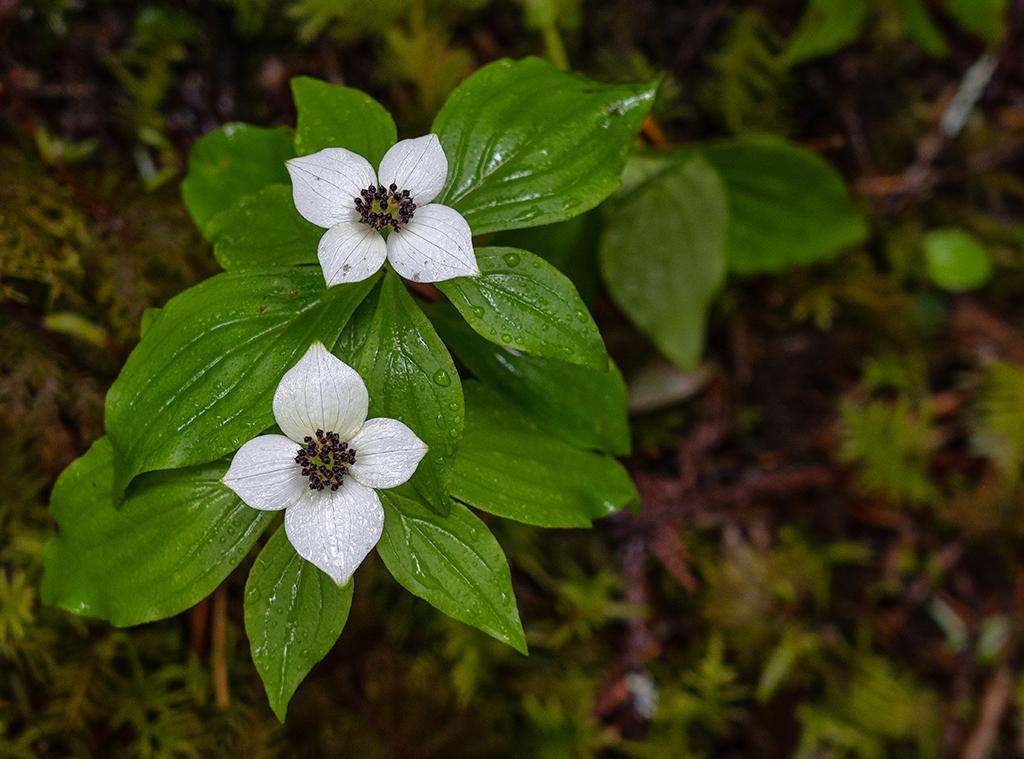
Dwarf dogwood (aka bunchberry), Mount Rainier National Park / Rebecca Latson
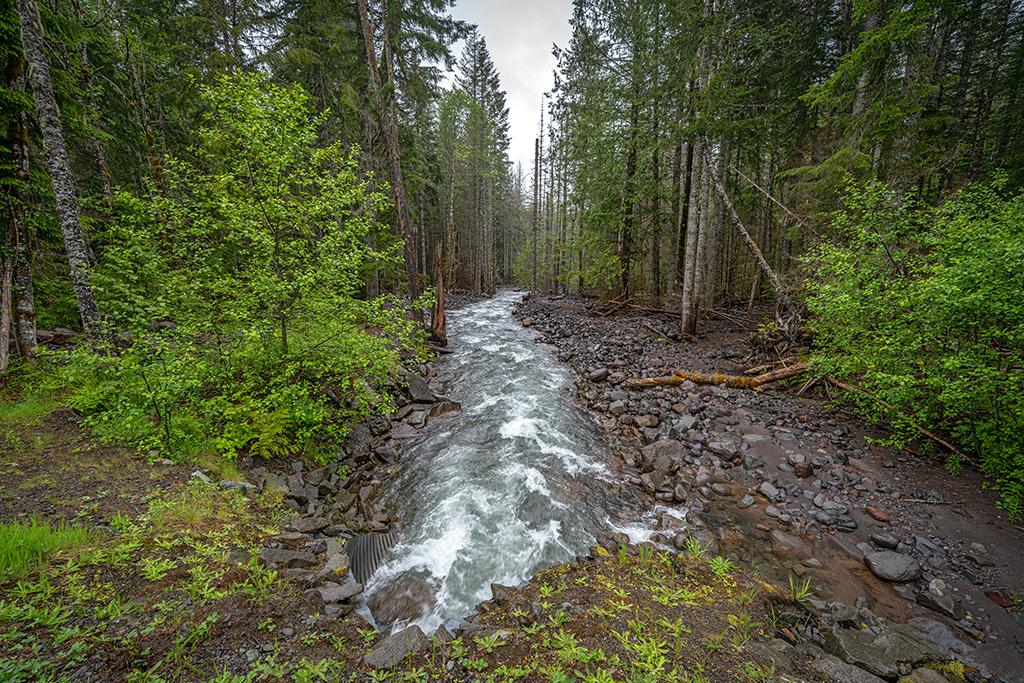
A late-spring rush of water, Mount Rainier National Park / Rebecca Latson

New growth, Mount Rainier National Park / Rebecca Latson
A venture into the interior of Mount Rainier’s lowland forests, where the tree canopy protects you from the heavier rainfall, opens up a world of brilliant greens and shadowy browns. I heard nothing but the pitter-patter of raindrops on leaves, interrupted by an occasional car driving past.

The path into the forest, Mount Rainier National Park / Rebecca Latson
The Kautz Creek parking area was empty save for a single car. I didn’t see any cars parked at the National Park Inn in Longmire, although I saw quite a few vehicles parked within other portions of that Historic District – perhaps they were mainly staff, and it *was* still early in the morning. Cougar Rock campground was closed off. I saw a single car at the tiny Christine Falls parking lot. For the first time ever, I got to enter Ricksecker Point. Every time I’ve driven this road to Paradise, Ricksecker Point was always closed.
Even though Mount Rainier was not showing itself, I still captured wonderful shots, including the ones on the bridge over the Nisqually River, and the one at Ricksecker Point looking down toward that same bridge in the distance, where I’d been not more than 20 minutes earlier.
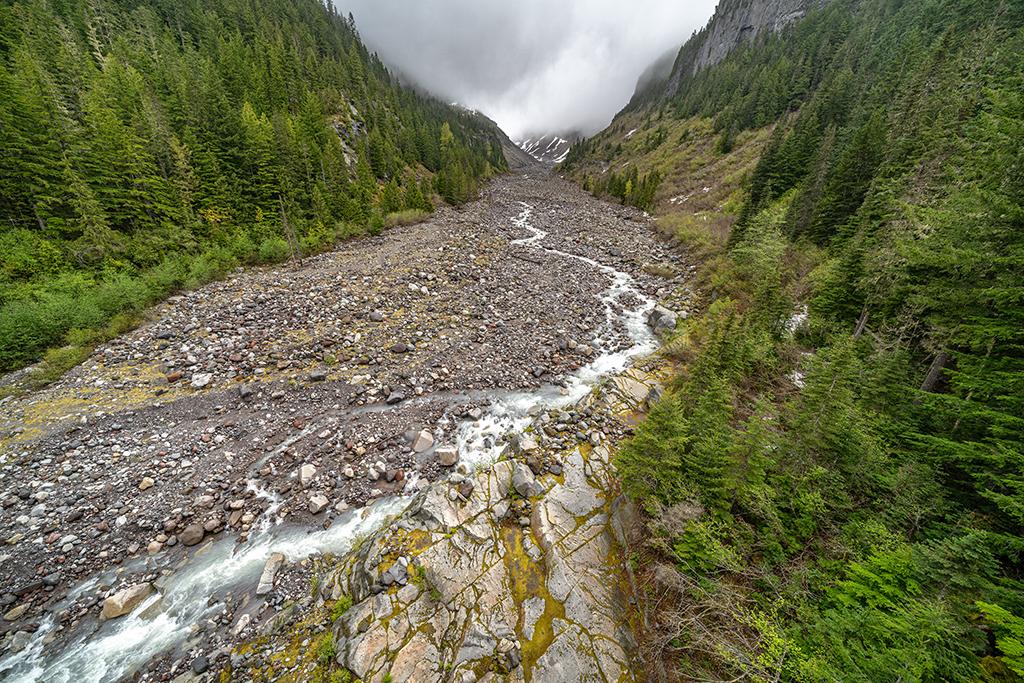
The view upriver, Mount Rainier National Park / Rebecca Latson

The view downriver, Mount Rainier National Park / Rebecca Latson

A view of river and bridge from Ricksecker Point, Mount Rainier National Park / Rebecca Latson
I also photographed some graffiti there (People, why do you do this??) and helped my karma by picking up (using a paper towel) and disposing of an entire tube of lotion that had been squished and left in the parking lot. I’m going to be generous with whoever left it and believe it must have fallen out of their car unnoticed.

Graffiti at Ricksecker Point, Mount Rainier National Park / Rebecca Latson
I saw three cars in the Narada Falls parking lot and not very many more in the Paradise parking lot. Of course, it was foggy, visibility was slim, and the wet snow for which the Pacific Northwest is famous pelted down upon the entire scene. FYI, during June and July, the snow is still pretty thick up at Paradise, so if you visit, pack some snowshoes.

The Paradise parking lot, Mount Rainier National Park / Rebecca Latson
On my way down from Paradise, I took the turnoff onto Stevens Canyon Road. This road is currently only open from the west to the Bench and Snow Lakes trail. I stopped at Reflection Lakes, bare of any reflections at this time.
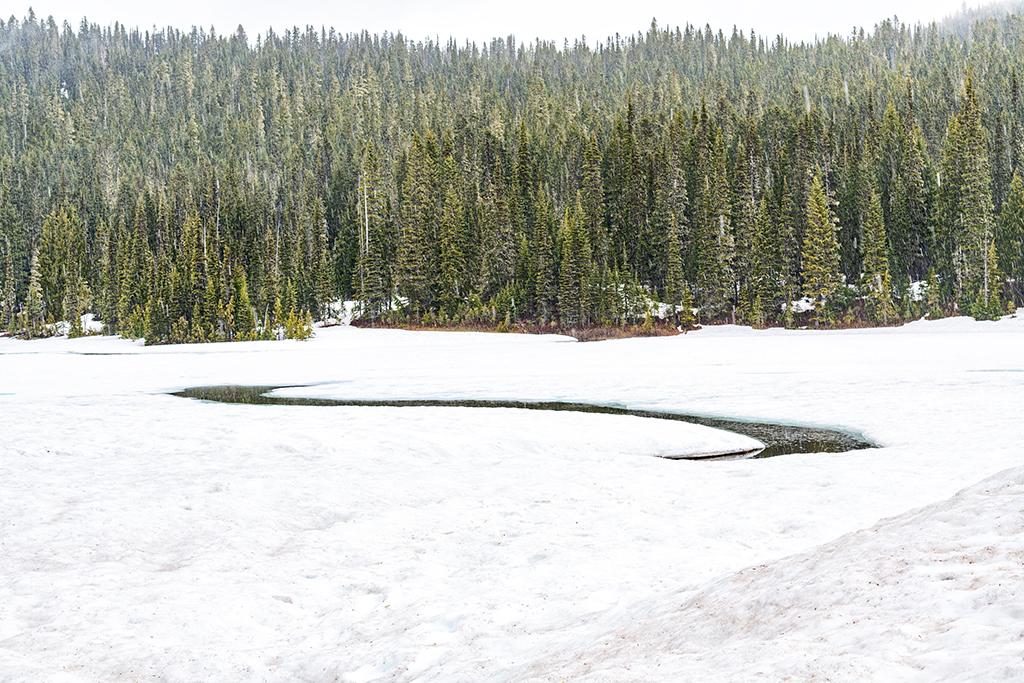
An s-curve of water at Reflection Lakes, Mount Rainier National Park / Rebecca Latson
To my delight, a Steller’s jay and a gray jay (aka Canada jay) were happy to entertain me and my camera’s telephoto lens.
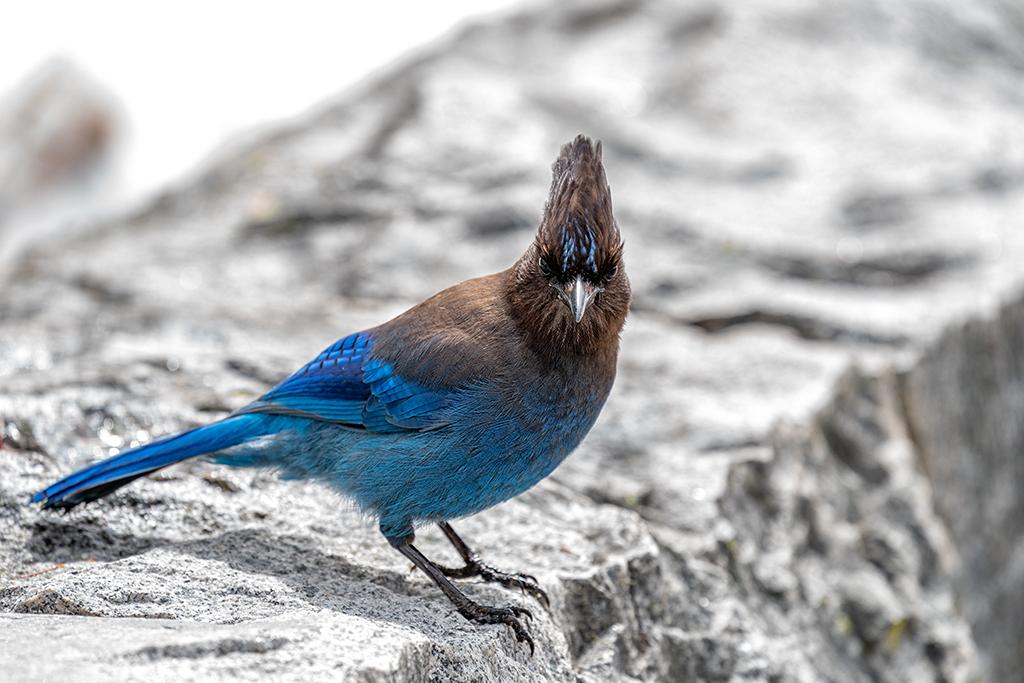
A stellar shot of a Steller's jay, Mount Rainier National Park / Rebecca Latson
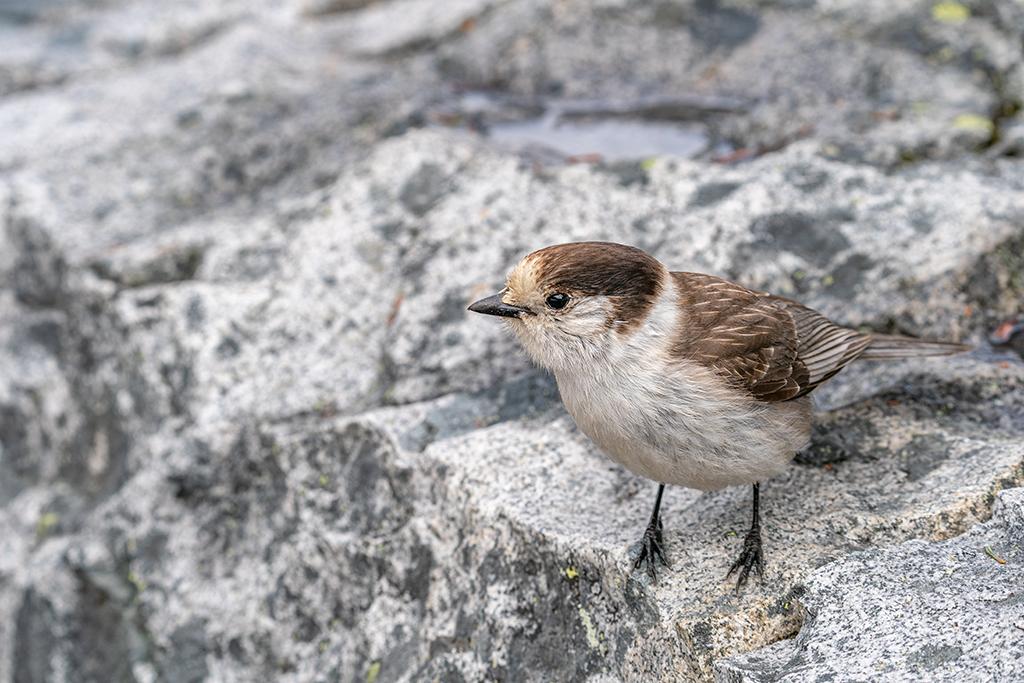
A Canada jay (aka gray jay) posing for the camera, Mount Rainier National Park / Rebecca Latson
I wanted to see what Upper Sunbeam Falls looked like, so after my visit with the birdies, I drove further down and stopped at the falls to practice my silky water technique.

Upper Sunbeam Falls, Mount Rainier National Park / Rebecca Latson
I opted to not return to Yakima via Hwy 123 and Chinook Pass. I had a feeling I would still not see Mount Rainier and I’m certain Tipsoo Lake is mainly snowed/iced over. As such, I don’t know if there were many people at the Grove of Patriarchs trail. Did any of you readers take that trail recently?
As I headed back down toward the Nisqually entrance, I could see, even in the rain, the parking area for Christine Falls was full. More cars passed by on the other side of the road.
I can report that, on this day, there were few people visiting the park while I was there. I left around 12:30 p.m. so that may have changed. I have a strong feeling that a blue-sky day with The Mountain in view will create totally different circumstances from my own experience. The Paradise, Christine Falls, Narada Falls, and National Park Inn parking lots could very easily reach their capacities on such a day.
All in all, it was a mixed day. I was happy to get back out with my cameras and pleased with the shots I captured. I also tried out three new lenses, two of which are stellar (not Steller) and one which I need to return as a bust. When I got home to download the images, NONE of those using that one lens turned out. I thought I'd tested this lens at home, but apparently not as thoroughly as I should. All I could do was sigh and count my blessings. Better to discover a bad lens now rather than during a much longer trip to a national park I might only visit once. Let that be a lesson to you readers: try out your new camera gear before heading out on that once-in-a-lifetime national park trip.

Forest magic, Mount Rainier National Park / Rebecca Latson
Ok, now for the public health message. When you visit Mount Rainier, or any national park that’s reopened, please practice social distancing. If not for yourself, then for the park staff and others nearby. Take a mask along to wear during those times you might be at a very popular, crowded spot in the park. Truly, I can’t understand why people get so bent out of shape over wearing a mask. It’s not that difficult to put on, and it protects others from your own breath, sneeze, and cough molecules. Coronavirus is not going away anytime soon, and this virus does not discriminate between the young, the old, the healthy, or the infirm. Plan accordingly and you’ll still have fun while staying safe and helping others to stay safe, too.




 Support Essential Coverage of Essential Places
Support Essential Coverage of Essential Places







Comments
Nice article and pics. Thanks for sharing. On the same day that you visited the Paradise area, my wife and I drove from the west side, up hwy 410, to the top of Chinook Pass (hoped to get a hike around Tipsoo Lake but still massive amounts of snow).
We then backtracked on 410 and turned on to Hwy 123 towards Ohanapecosh/Stevens Canyon area. By mid afternoon, the parking lot for the Grove of the Patriarchs trail was full. Unfortunately we couldn't complete the short hike due to no social distancing or use of face masks. We were the ONLY ones practicing those habits. That was disappinting...
We did however enjoy the longer hike to Silver Falls from the same parking lot. Much fewer hikers so it was easy to keep ourselves distanced from others.
Photography questions: what is your shutter speed and f-stop on the silky waterfall shot?
Hi Tom W! Thanks for the info. I had a feeling there would be tons of snow around Tipsoo Lake - there probably will continue to be up into July. And I had a feeling things would be crowded at Grove of the Patriarchs, too. I'm not one bit surprised about the social distancing / face mask thing. I wore a face mask when I went down to photograph at the bridge over the Nisqually River and got a little shade thrown at me by a lady who told me I should take my mask off.
In answer to your question, I was using a shutter speed of 1.6 seconds. I had a polarizer filter over the lens, but it wasn't that dark, so I used an f-stop of f/22, and an ISO of 100 to allow me to use a slower shutter speed without overexposing everything else in the image. In retrospect, I should have affixed a darker neutral density filter over the lens instead of that polarizer I used.
I'll have to try that hike to Silver Falls the next time I am out there. I've never been to that one.
Stay safe out there!
Thanks for the info.
Your photo looks great. It's tricky with waterfalls to get just the right shutter speed. Sometimes 1/4 second looks the best and sometimes its 3 seconds!
Your lens looks really sharp for being stopped down so far. I try to stay in the 5.6- 11 range with my lenses to keep things sharp. But sometimes that prevents me from putting a lot of forground in due to smaller depth of field.
Nice work!
Thanks for sharing your beautiful photos and for the photography tips!
Rebecca - as always, i can feel nothing but admiration for your work and your commentary. As a longtime PNWer, the question of if "the Mountain is out" is a common topic and familiar language. I always look forward to a new issue from your camp and hope you continue your fine work as long as you would wish to.
Thanks for your report and sharing an impressive morning's work. I suppose you've considered an umbrella for your tripod?
There is a large blocking blowdown reported on the Silver Falls trail from Stevens Canyon Entrance:
https://www.wta.org/go-hiking/trip-reports/trip_report-2020-06-05-205690...
As long as the campground remains closed, the approach trail(s) from that end should be much less crowded. The shortest approach (~ half-mile) of all is from a small turnout with sign along SR 123, but it's a bit steep at the start. There's not much room for social distancing at the lower overlooks & bridge, probably the best photo locations. The mid-day rainbows are impressive from the larger upper overlook, but it's a bit rough near the railings, with big rock steps that funnel traffic.
https://www.wta.org/go-hiking/hikes/silver-falls-loop
I think you'd also find the first trail bridge a couple hundred yards up the otherwise steep Comet Falls trail worthy of a visit. There is a better chance to maintain social distance there, but the early bird gets the parking spot.
Thanks for the heads up, tahoma. I've been looking at the weather reports and am planning a trip back perhaps as early as this week. Silver Falls and Comet Falls sound pretty inviting. As for using an umbrella, I have to tell you it's enough to carry camera and tripod without the extra added burden of the umbrella, although I think there's a mini-umbrella setup for either camera or tripod that I thought I saw for sale in some online photo shop.
Thank you, Rick. You are far too kind, but your words are music to my photographer's ears. :)